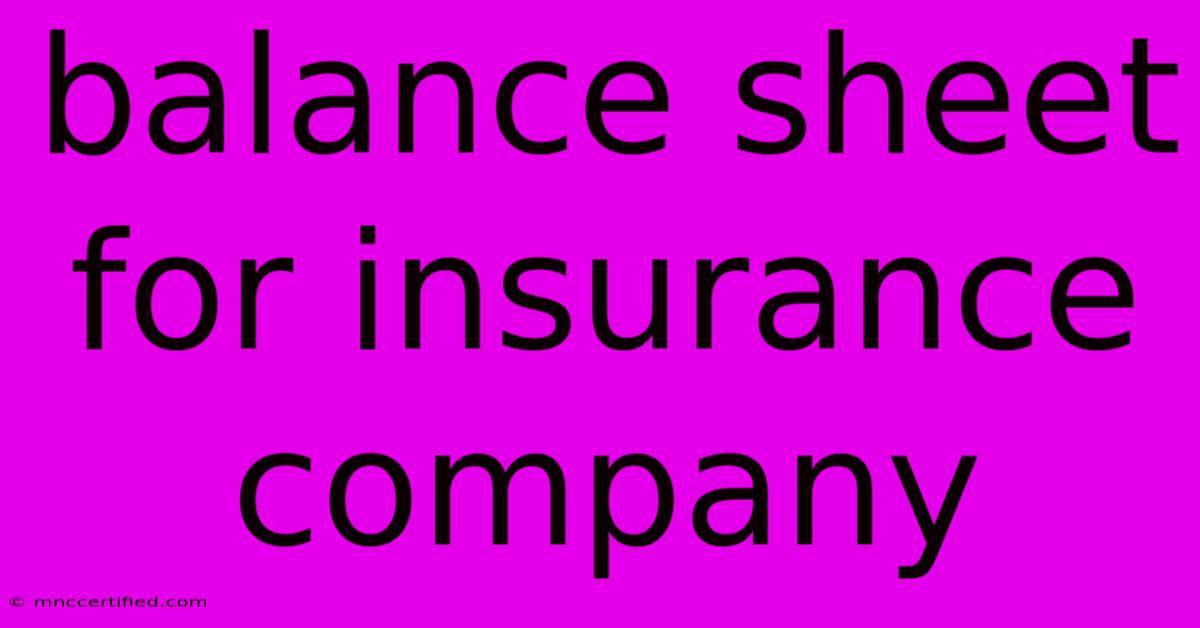Balance Sheet For Insurance Company

Table of Contents
Understanding the Balance Sheet of an Insurance Company
The balance sheet is a fundamental financial statement that provides a snapshot of an insurance company's financial position at a specific point in time. It presents a structured view of the company's assets, liabilities, and equity, showcasing how the company is financed and what it owns.
For insurance companies, the balance sheet holds special significance due to the nature of their business. Let's delve into the components of an insurance company's balance sheet and understand their implications:
1. Assets: What an Insurance Company Owns
Insurance companies primarily hold assets to support their operations and ensure the fulfillment of their financial obligations to policyholders. Here are some key asset categories found on their balance sheets:
- Investments: This is typically the largest asset category for insurance companies. They invest premiums collected from policyholders in various financial instruments such as stocks, bonds, real estate, and other assets. The goal is to generate returns to cover future claims and operating expenses.
- Cash and Cash Equivalents: This category includes liquid assets like cash on hand, bank deposits, and short-term investments that can be easily converted into cash.
- Real Estate: Insurance companies may own properties, like office buildings or investment properties, to generate rental income or provide space for their operations.
- Policyholders' Surplus: This represents the amount of money an insurance company holds in excess of its liabilities. It serves as a buffer to absorb unexpected losses and provides a cushion for future policyholder claims.
2. Liabilities: What an Insurance Company Owes
An insurance company's liabilities represent its financial obligations to others. The most significant liability for an insurance company is:
- Reserves: These are the funds set aside to cover future claims arising from insurance policies. They represent the company's contractual obligation to pay out benefits to policyholders who experience covered events. Reserves are categorized based on the type of insurance product, such as life insurance reserves, health insurance reserves, and property and casualty insurance reserves.
- Deferred Acquisition Costs (DAC): These represent the costs associated with acquiring new policies, spread over the life of the policy.
- Other Liabilities: This category encompasses various liabilities like unpaid bills, taxes payable, and accrued expenses.
3. Equity: The Owners' Stake
Equity represents the ownership stake in the insurance company. It is calculated as the difference between assets and liabilities. For publicly traded companies, equity is also referred to as "shareholders' equity." Here's how it is represented:
- Capital Stock: This represents the value of the company's shares issued to investors.
- Retained Earnings: This represents the accumulated profits that the company has not distributed to shareholders in the form of dividends.
Key Ratios for Analyzing the Balance Sheet
Financial analysts often use key ratios to assess an insurance company's financial health and performance. These ratios provide insights into the company's solvency, profitability, and risk management. Some important ratios to consider are:
- Combined Ratio: This ratio measures the company's underwriting profitability. A combined ratio below 100% indicates underwriting profitability, while a ratio above 100% suggests underwriting losses.
- Return on Equity (ROE): This ratio measures the company's profitability relative to its equity. A higher ROE indicates better financial performance.
- Debt-to-Equity Ratio: This ratio assesses the company's leverage. A higher ratio suggests more debt financing and potentially higher financial risk.
The Importance of Balance Sheet Analysis
Analyzing an insurance company's balance sheet provides valuable insights into its financial health and future prospects. It helps investors, regulators, and industry analysts understand:
- Solvency: Whether the company has sufficient assets to cover its liabilities.
- Risk Management: How effectively the company manages its exposure to potential claims.
- Investment Strategy: The company's investment portfolio and its ability to generate returns.
- Growth Potential: The company's ability to expand its operations and secure new business.
Conclusion
Understanding the balance sheet of an insurance company is crucial for investors, policyholders, and industry professionals. By analyzing the company's assets, liabilities, and equity, stakeholders can gain valuable insights into its financial position and future prospects. This knowledge empowers them to make informed decisions about investing, choosing insurance products, and assessing the overall health of the insurance sector.

Thank you for visiting our website wich cover about Balance Sheet For Insurance Company. We hope the information provided has been useful to you. Feel free to contact us if you have any questions or need further assistance. See you next time and dont miss to bookmark.
Featured Posts
-
Nba Bucks Vs Raptors At Fiserv Forum
Nov 13, 2024
-
Life Insurance Companies Greensboro
Nov 13, 2024
-
Parkinson Wrexham Injury Update Before Stockport
Nov 13, 2024
-
Paul Mescal Spezial Your New Sneaker Staple
Nov 13, 2024
-
Nba Cup Celtics Vs Hawks Tuesday Night
Nov 13, 2024